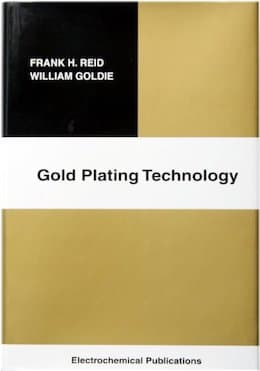
-----
Jewelry Plating -- Need hard gold not soft gold
2001
Q. We are a wholesale company currently importing "Chain by the Inch" and pre-made fashion/costume Jewelry from the USA. We have major problems with the gold wearing off the chain fairly quickly and the Nickel showing. This gives a dull finish and obviously unhappy customers.
We have some competition here in Australia which, when tested, appeared to have 40 mils gold with a Yellow bronze plate underneath. I believe that when the gold wears through, the Yellow Bronze still gives the appearance of the gold and the customers are generally none the wiser. This company's chains generally last 3 years of continual wear and this is the type of wearability we require.
I have just taken a quick trip to ASIA to source a supplier of raw brass chain and are awaiting shipment of a large order. We now need to get the plating formula up to spec to provide a very high quality fashion chain.
I have also been advised that if the gold wears down to the yellow bronze, it will tarnish very quickly. This does not seem to be the case with our competitors chain.
I have tried an acrylic sealant but this seems to give after a week or so and leaves the chain looking pretty ordinary.
If anyone out there could help me with some suggestions, it would be much appreciated and would help in establishing a leading company in fashion jewelry throughout Australia.
Regards
Wayne Singletary- Australia
A. You should be able to have the quality of plating you require produced in Australia. There are a number of high quality platers who can offer the finish you require. From your description you seem to be describing hard gold plating over a bronze undercoat.
Regards

Bob Lynch
plating company - Sydney, Australia
2001
A. It seems to me that you are using soft gold. This, I suspect, is very pure, so it will be both economically and technically beneficial if you use a hard gold bath. This will increase the wear resistance of the gold overlay and reduce the amount of expensive gold being deposited.
Alternatively you can coat the chain in titanium nitride; this is a very hard (typical 2,200Hv) gold coloured material that also offers good wear resistance. It is deposited by vacuum techniques. The titanium nitride can then be plated with gold or a gold alloy to give the gold surface. The beauty of this is that the titanium nitride is a (relatively) rough deposit and the gold infills the valleys in the TiN. As the gold wears off the outer surface, the peaks of the TiN are exposed, thereby reducing the wear rate and maintaining the gold colouration.
One other thing strikes me; as you are probably aware, it is now illegal to sell jewellery in Europe that allows the release of nickel at a rate of more than 0.5ug/cm2/week. This is because of the high rates of dermatitis and allergic sensitivity caused by nickel. By using nickel you are limiting your potential export market by a population factor greater than the USA. Europe is not the only economic zone concerned about nickel allergies, so it is probable that this nickel ban will become more widespread. Why not bite the bullet now and seek an alternative to nickel as a barrier layer? One recommended layer is copper-tin (bronze) and by choosing the right alloy mix, you should be able to get a "goldish looking" layer. However, the alloy composition of copper-tin varies with the applied current density, so you may suffer from colour variation of the Cu-Sn alloy. It also has another down side; I believe the only commercial solutions are based on cyanide. If anyone knows of a non-cyanide Cu-Sn bath, I would be very interested in further details.

Trevor Crichton
R&D practical scientist
Chesham, Bucks, UK
2001
Strike Hard Gold Plating
Q. Hello, All colleagues.
Please, can anyone suggest a composition for strike hard gold electroplating?
Also I need the operational conditions of this composition.
Best Regards,
plating shop employee - Iraq
September 12, 2016
by Reid & Goldie
-- hard to find & expensive; if you see a copy cheap, act fast!

on eBay or Amazon
or AbeBooks
(affil link)
A. Hi cousin Aaed. Hard gold is often obtained by alloying cobalt or other metals with the gold in cyanide baths. But if you need high purity acid gold, alum and hydrazine sulphate have been reported as hardening agents but may function simply by reducing grain size according to Goldie. .
Strikes often contain a low gold concentration in order to discourage immersion deposits. Goldie reports a strike from the 1930's with sodium gold cyanide of 6.25 g/l, sodium cyanide of 50 g/l, and HCl of 450 ml/l, but cautions how dangerous this is to prepare and that it must only be done under a fume hood. We appreciate your inquiry but there are two problems with it ...
The first is that in this country virtually no plating shops formulate their own gold plating solutions; we almost always buy from specialized suppliers who have determined over the course of decades of development what the most effective formulations are. These formulations are held as proprietary trade secret, and people cannot reveal them. If someone unknown to us were to answer you, we would not know whether their knowledge was legitimate or they are a disgruntled employee posting with a fictitious name and revealing trade secrets. So we are limited to very general info and telling you about books and published articles containing those formulations.
The second problem is that "strike" may hold a different meaning for different readers. To some it simply means a flash, i.e., a very thin plating; to others it means a low concentration bath designed to minimize immersion deposits. That's one reason why we ask people to please post the full details of their own situation rather than abstract questions. What are you applying a hard gold strike to and why? Exactly what do you mean by a strike? Thanks!
Regards,

Ted Mooney, P.E. RET
Striving to live Aloha
finishing.com - Pine Beach, New Jersey
Ted is available for instant help
or longer-term assistance.
September 2016
Q, A, or Comment on THIS thread -or- Start a NEW Thread